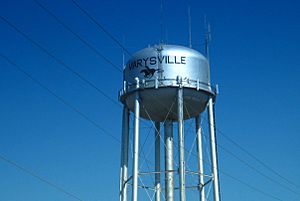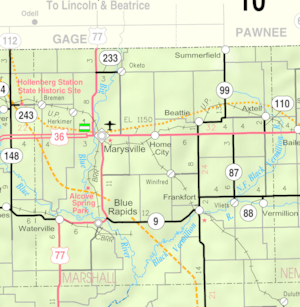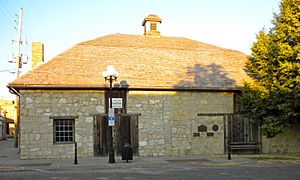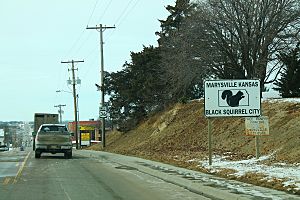Marysville, Kansas facts for kids
Quick facts for kids
Marysville, Kansas
|
|
|---|---|
|
City and County seat
|
|

Marysville water tower (2009)
|
|

Location within Marshall County and Kansas
|
|

|
|
| Country | United States |
| State | Kansas |
| County | Marshall |
| Platted | 1855 |
| Incorporated | 1861 |
| Area | |
| • Total | 4.61 sq mi (11.94 km2) |
| • Land | 4.58 sq mi (11.86 km2) |
| • Water | 0.03 sq mi (0.08 km2) |
| Elevation | 1,234 ft (376 m) |
| Population
(2020)
|
|
| • Total | 3,447 |
| • Density | 747.7/sq mi (288.69/km2) |
| Time zone | UTC-6 (CST) |
| • Summer (DST) | UTC-5 (CDT) |
| ZIP codes |
66508, 66555
|
| Area code | 785 |
| FIPS code | 20-45050 |
| GNIS ID | 485620 |
Marysville is a city in and the county seat of Marshall County, Kansas, United States. As of the 2020 census, the population of the city was 3,447.
Contents
History
Marysville was laid out in 1855 by Francis J. Marshall, and designated in that same year the county seat. It was incorporated as a city in 1861.
Marysville was located on the Oregon Trail and the route of the Pony Express, the St. Joe Road, the Overland Stage, The Military Road, and the Otoe-Missouria Trail. British explorer Richard Francis Burton en route to California in 1860 noted: "Passing by Marysville, in old maps Palmetto City, a country-town which thrives by selling whiskey to ruffians of all descriptions ..." The old Pony Express Station still stands in downtown Marysville. In Beyond the Mississippi (1867), Albert D. Richardson, who passed through Marysville in 1860, wrote that the town—which was named after the Border Ruffian Marshall's wife—"had 50 houses and was famed for whisky and shooting affrays."
Marysville owed much of its prosperity to the Union Pacific Railroad, which became a major employer. But as the city grew along the railroad most of the community was across the tracks from a good part of downtown. As rail traffic increased, vehicular delays were estimated at 7.5 to 8 hours per day at the five grade crossings, which also affected emergency vehicles. In 2006 the main line was moved out of the center of town to a bypass to the south and west, with grade separations for US-36 and US-77.
Marysville is also known as the "Black Squirrel City" due to an isolated community of all-black squirrels that make their homes in the town. The squirrels are said to be the result of escapees from a traveling circus.
Geography
Marysville is located in northeast Kansas near the Nebraska border, about 75 miles (120 km) northwest of the Kansas capital of Topeka and 67 miles (108 km) south of Lincoln, Nebraska. According to the United States Census Bureau, the city has a total area of 4.62 square miles (11.97 km2), of which 4.58 square miles (11.86 km2) is land and 0.04 square miles (0.10 km2) is water.
Climate
| Climate data for Marysville, Kansas (1991–2020 normals, extremes 1950–present) | |||||||||||||
|---|---|---|---|---|---|---|---|---|---|---|---|---|---|
| Month | Jan | Feb | Mar | Apr | May | Jun | Jul | Aug | Sep | Oct | Nov | Dec | Year |
| Record high °F (°C) | 71 (22) |
84 (29) |
92 (33) |
97 (36) |
102 (39) |
108 (42) |
112 (44) |
110 (43) |
109 (43) |
97 (36) |
87 (31) |
74 (23) |
112 (44) |
| Mean maximum °F (°C) | 60.4 (15.8) |
67.4 (19.7) |
79.2 (26.2) |
86.6 (30.3) |
91.5 (33.1) |
96.0 (35.6) |
100.4 (38.0) |
99.4 (37.4) |
94.8 (34.9) |
88.8 (31.6) |
74.0 (23.3) |
63.6 (17.6) |
102.1 (38.9) |
| Mean daily maximum °F (°C) | 38.2 (3.4) |
43.3 (6.3) |
55.3 (12.9) |
65.7 (18.7) |
75.7 (24.3) |
85.6 (29.8) |
90.2 (32.3) |
88.6 (31.4) |
81.2 (27.3) |
69.2 (20.7) |
54.2 (12.3) |
42.2 (5.7) |
65.8 (18.8) |
| Daily mean °F (°C) | 26.7 (−2.9) |
31.3 (−0.4) |
42.5 (5.8) |
52.8 (11.6) |
63.7 (17.6) |
73.9 (23.3) |
78.5 (25.8) |
76.3 (24.6) |
67.9 (19.9) |
55.3 (12.9) |
41.9 (5.5) |
30.9 (−0.6) |
53.5 (11.9) |
| Mean daily minimum °F (°C) | 15.3 (−9.3) |
19.3 (−7.1) |
29.6 (−1.3) |
40.0 (4.4) |
51.6 (10.9) |
62.1 (16.7) |
66.8 (19.3) |
64.1 (17.8) |
54.5 (12.5) |
41.4 (5.2) |
29.5 (−1.4) |
19.5 (−6.9) |
41.1 (5.1) |
| Mean minimum °F (°C) | −5.8 (−21.0) |
−0.4 (−18.0) |
9.9 (−12.3) |
23.3 (−4.8) |
35.3 (1.8) |
48.3 (9.1) |
54.5 (12.5) |
52.0 (11.1) |
37.5 (3.1) |
24.0 (−4.4) |
13.2 (−10.4) |
0.8 (−17.3) |
−9.6 (−23.1) |
| Record low °F (°C) | −21 (−29) |
−28 (−33) |
−18 (−28) |
6 (−14) |
15 (−9) |
35 (2) |
42 (6) |
44 (7) |
27 (−3) |
11 (−12) |
−3 (−19) |
−27 (−33) |
−28 (−33) |
| Average precipitation inches (mm) | 0.83 (21) |
1.07 (27) |
2.11 (54) |
3.09 (78) |
4.86 (123) |
4.91 (125) |
4.65 (118) |
3.61 (92) |
3.28 (83) |
2.52 (64) |
1.50 (38) |
1.17 (30) |
33.60 (853) |
| Average snowfall inches (cm) | 4.9 (12) |
4.3 (11) |
1.5 (3.8) |
0.7 (1.8) |
0.0 (0.0) |
0.0 (0.0) |
0.0 (0.0) |
0.0 (0.0) |
0.0 (0.0) |
0.1 (0.25) |
1.0 (2.5) |
3.3 (8.4) |
15.8 (40) |
| Average precipitation days (≥ 0.01 in) | 4.7 | 5.2 | 6.8 | 9.3 | 11.3 | 11.1 | 10.5 | 10.1 | 8.9 | 7.7 | 5.8 | 5.0 | 96.4 |
| Average snowy days (≥ 0.1 in) | 2.1 | 2.1 | 0.9 | 0.2 | 0.0 | 0.0 | 0.0 | 0.0 | 0.0 | 0.2 | 0.6 | 1.3 | 7.4 |
| Source: NOAA | |||||||||||||
Demographics
| Historical population | |||
|---|---|---|---|
| Census | Pop. | %± | |
| 1860 | 171 | — | |
| 1870 | 300 | 75.4% | |
| 1880 | 1,249 | 316.3% | |
| 1890 | 1,913 | 53.2% | |
| 1900 | 2,006 | 4.9% | |
| 1910 | 2,260 | 12.7% | |
| 1920 | 3,048 | 34.9% | |
| 1930 | 4,013 | 31.7% | |
| 1940 | 4,055 | 1.0% | |
| 1950 | 3,866 | −4.7% | |
| 1960 | 4,143 | 7.2% | |
| 1970 | 3,588 | −13.4% | |
| 1980 | 3,670 | 2.3% | |
| 1990 | 3,359 | −8.5% | |
| 2000 | 3,271 | −2.6% | |
| 2010 | 3,294 | 0.7% | |
| 2020 | 3,447 | 4.6% | |
| U.S. Decennial Census | |||
2020 census
The 2020 United States census counted 3,447 people, 1,458 households, and 841 families in Marysville. The population density was 755.6 per square mile (291.7/km2). There were 1,682 housing units at an average density of 368.7 per square mile (142.4/km2). The racial makeup was 91.21% (3,144) white or European American (90.14% non-Hispanic white), 0.78% (27) black or African-American, 0.23% (8) Native American or Alaska Native, 0.9% (31) Asian, 0.06% (2) Pacific Islander or Native Hawaiian, 0.64% (22) from other races, and 6.18% (213) from two or more races. Hispanic or Latino of any race was 3.95% (136) of the population.
Of the 1,458 households, 27.8% had children under the age of 18; 44.2% were married couples living together; 29.0% had a female householder with no spouse or partner present. 37.4% of households consisted of individuals and 17.4% had someone living alone who was 65 years of age or older. The average household size was 2.2 and the average family size was 3.0. The percent of those with a bachelor’s degree or higher was estimated to be 16.9% of the population.
25.4% of the population was under the age of 18, 6.8% from 18 to 24, 22.9% from 25 to 44, 23.8% from 45 to 64, and 21.0% who were 65 years of age or older. The median age was 40.0 years. For every 100 females, there were 102.1 males. For every 100 females ages 18 and older, there were 106.4 males.
The 2016-2020 5-year American Community Survey estimates show that the median household income was $44,037 (with a margin of error of +/- $9,276) and the median family income was $64,099 (+/- $9,753). Males had a median income of $40,000 (+/- $9,158) versus $29,180 (+/- $4,513) for females. The median income for those above 16 years old was $32,774 (+/- $6,479). Approximately, 7.3% of families and 11.9% of the population were below the poverty line, including 21.5% of those under the age of 18 and 7.9% of those ages 65 or over.
2010 census
As of the census of 2010, there were 3,294 people, 1,468 households, and 859 families living in the city. The population density was 719.2 inhabitants per square mile (277.7/km2). There were 1,646 housing units at an average density of 359.4 per square mile (138.8/km2). The racial makeup of the city was 96.7% White, 0.3% African American, 0.2% Native American, 0.6% Asian, 0.8% from other races, and 1.4% from two or more races. Hispanic or Latino of any race were 2.6% of the population.
There were 1,468 households, of which 27.2% had children under the age of 18 living with them, 46.1% were married couples living together, 8.4% had a female householder with no husband present, 4.0% had a male householder with no wife present, and 41.5% were non-families. 38.1% of all households were made up of individuals, and 18.1% had someone living alone who was 65 years of age or older. The average household size was 2.20 and the average family size was 2.89.
The median age in the city was 41.8 years. 24% of residents were under the age of 18; 7% were between the ages of 18 and 24; 22.2% were from 25 to 44; 26.4% were from 45 to 64; and 20.5% were 65 years of age or older. The gender makeup of the city was 47.9% male and 52.1% female.
Education
The community is served by Marysville USD 364 public school district.
Notable people
- Helen Arnold, Oklahoma House of Representative legislator (1976–82)
- Kenneth Dam, Deputy Secretary of State (1982–85)
- Brian Duensing, professional baseball player
- Ralph Elliott, accountant and developer of the Elliott Wave Theory
- Louis Hardin, a.k.a. Moondog, composer, musician and poet
- Michael McClure, poet and playwright
- Kendra Wecker, collegiate and professional basketball player
See also
 In Spanish: Marysville (Kansas) para niños
In Spanish: Marysville (Kansas) para niños



